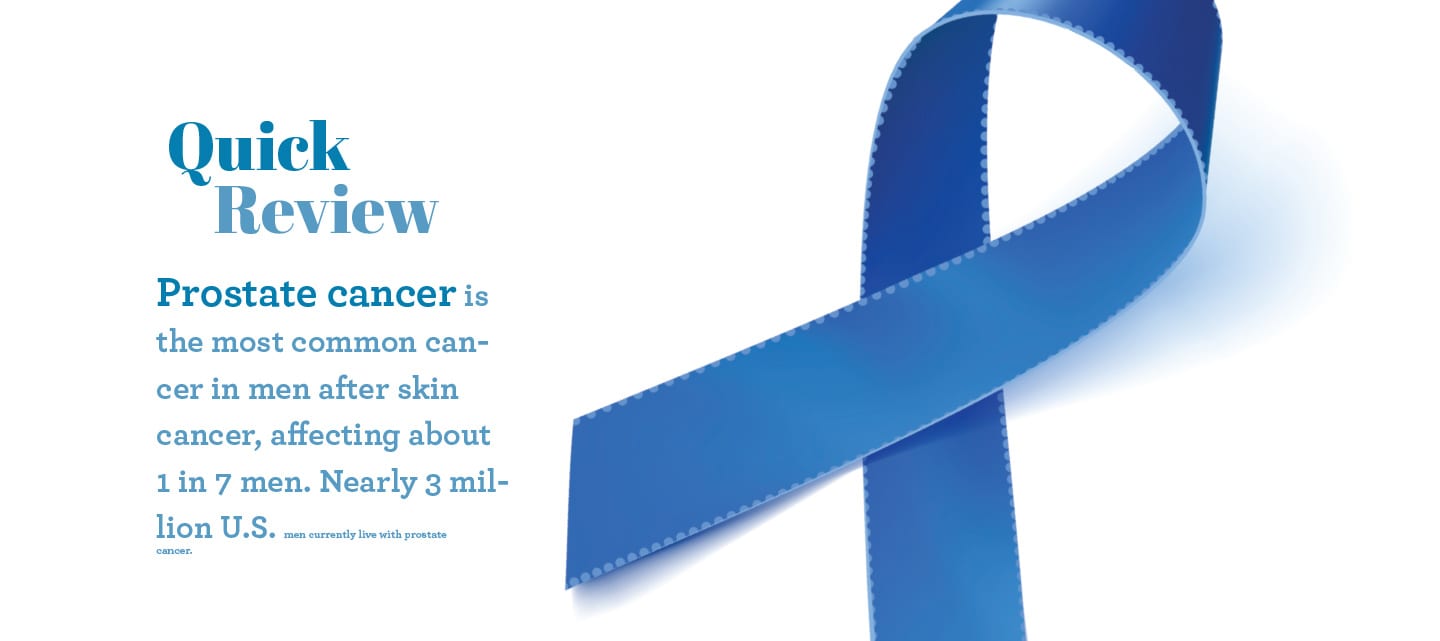When we hear the word “cancer,” most of us immediately think “life-threatening.” But prostate cancer can be slow-growing and never progress to taking your life. Case in point: 1 man in 7 will get prostate cancer in his lifetime, but only 1 man in 39 will die of it.
While this is good news, the uncertainty it brings can make treatment decisions incredibly complicated for men. You don’t want to be the 1 in 39 who dies from aggressive cancer, but at the same time, you don’t want to undergo a procedure unless you really need it.
What’s a man to do? How can he navigate the waters? We talked to two urologists about what all men should know when it comes to prostate cancer screening, diagnosis, and treatment. What we learned might just save your life.
 1.Prostate cancer really can kill you.
1.Prostate cancer really can kill you.
A common line of thinking among men goes: Prostate cancer is inevitable. If you get it, you will probably die of something else. And while there is validity to that statement for some men, it trivializes just how deadly prostate cancer can be for others. Even though only 1 in 39 men diagnosed with prostate cancer will die of it, prostate cancer is still the second leading cause of cancer death in men, behind only lung cancer.
“To think of prostate cancer as benign and inevitable is deceptive,” says Dr. Lee Jackson, urological oncologist with CHI Memorial Robotics for Prostate Cancer. “We lose between 27,000 and 30,000 men every year to this disease. To these men and their families, it was more than a consequence of aging.”
2.It has no warning signs in its early stages.
Prostate cancer is one of the most asymptomatic cancers in all of oncology – meaning, you can have it and still feel great. The disease is usually first detected by a doctor during a check-up.
“In most cases, a man has no idea it’s there,” says Dr. Charles Idom, urologist with Hamilton Health Care System. “Only a few of the most aggressive cases cause symptoms in the early stages.”
Bottom line: to know if you have it you need to look for it. And the sooner you find it, the more treatment options you have. Which leads us to the next point…


The majority of prostate cancers are slow growing. But while some are trivial, others are lethal. The only way to know which kind you have is to get checked out.
Prostate cancer screening is about knowing your enemy. You could have a petty thief or a mass criminal, but either way, you are better off knowing what you’re up against. The worst thing is to have an aggressive disease and assume you are in a benign category. It’s better to know your enemy than bury your head in the sand.
4. Screening should begin once you’re over the hill.
Growing older is hands down the No. 1 risk factor for prostate cancer. A man’s risk of prostate cancer begins to climb around age 40 and shoots up exponentially in the following two decades. As many as 97% of prostate cancers occur in men 50 years of age and older.
But unlike many other types of cancer, prostate cancer does not have universal routine screening guidelines based on age. So once a man enters his 40s, he should have a candid conversation with his doctor about the best approach for him. “Around age 40, the game is on,” says Dr. Idom.
Generally speaking, average-risk men should begin routine screening at age 50, while those at high risk should begin even earlier. Standard prostate cancer screening includes two tests: a prostate-specific antigen (PSA) blood test and a digital rectal exam (DRE).


5. A diagnosis doesn’t necessarily mean you need treatment.
Urologists are unanimous: not all prostate cancers will need treatment. “In the past there was risk of overtreatment and the risk continues today. But that risk has diminished as screening tools have improved and more urologists have become comfortable with active surveillance,” says Dr. Jackson.
If you are diagnosed with prostate cancer, your doctor will assign your cancer to risk category: very low (Stage I), low (Stage II), intermediate (Stage III), or high (Stage IV). Men with cancer in one of the first two categories may only need to watch and wait.
“When we hear ‘cancer,’ we tend to think of short lead times between diagnosis and impact. But many prostate cancers won’t kill you,” says Dr. Idom.
6. If you do need treatment, your doctor will outline your options.
If you are diagnosed with prostate cancer, how can you ensure you won’t be overtreated? How do you make an informed decision about whether to watch and wait or pursue treatment?
Urologists say the answer is simple: education. Once a biopsy confirms the presence of cancer in your prostate, a urologist will use data from the pathologist’s report to characterize the potential aggressiveness of the cancer. He or she will then assign your cancer to a risk category.
Your doctor will discuss your risk category with you in the context of your life expectancy and health status. He or she will then make a recommendation on whether or not to treat it, and if you treat it, how to treat it in a way that best preserves your quality of life.
As a patient, your role is to learn everything you can about the risk associated with that category – and the pros and cons of each course of action – so you can play an active role in making an informed decision.


In the last decade, researchers have developed several biomarker tests to complement PSA testing. These tests are designed to better characterize a man’s risk of prostate cancer, and they show great potential for reducing the number of men who undergo unnecessary biopsies (which can be invasive and have their own risk profile) and treatments.
If you have an elevated PSA score, but your doctor isn’t ready to recommend a biopsy, he or she may suggest a prostate health index, or PHI (blood test), the 4Kscore (blood test), or a PCA3 test (urine test).
Your doctor will look at the results of these tests in a mathematical relationship to one another and calculate a value. This value will tell you whether you have sufficient risk to pursue further action. “Today, there are so many approaches rather than a knee-jerk response to an elevated PSA above an arbitrary number,” says Dr. Jackson.
Your doctor may also recommend multi-parametric MRI (mpMRI) before or after undergoing a biopsy. A minimally invasive procedure, mpMRI uses advanced imaging techniques to detect the size, shape, and location of prostate cancer, and can better risk stratify men who are under active surveillance.
8. New treatment options are improving outcomes.
Many men believe that if they undergo surgery or radiation for prostate cancer, they will inevitably suffer from urinary incontinence and sexual dysfunction. This is not necessarily true. These side effects are dependent on a man’s age and physical condition as well as the nature of the procedure.
For example, if a man’s prostate cancer is caught early, he may be eligible for emerging treatment modalities using ablation techniques. Focal cryosurgical ablation and high intensity focused ultrasound (HIFU) therapy offers a “middle ground” between active surveillance and more aggressive treatments like radiation and prostatectomy. The technique ablates, or removes, the cancerous portion of the prostate gland only rather than the whole gland. Thus, it decreases the potential side effects of therapy.
However, in order to have this option available to you, your prostate cancer must be small and localized. In other words, it must be found early. “The big take home is that it’s still very important to do screening,” says Dr. Idom. “Early treatment leads not only to better survival, but to better outcomes.”

